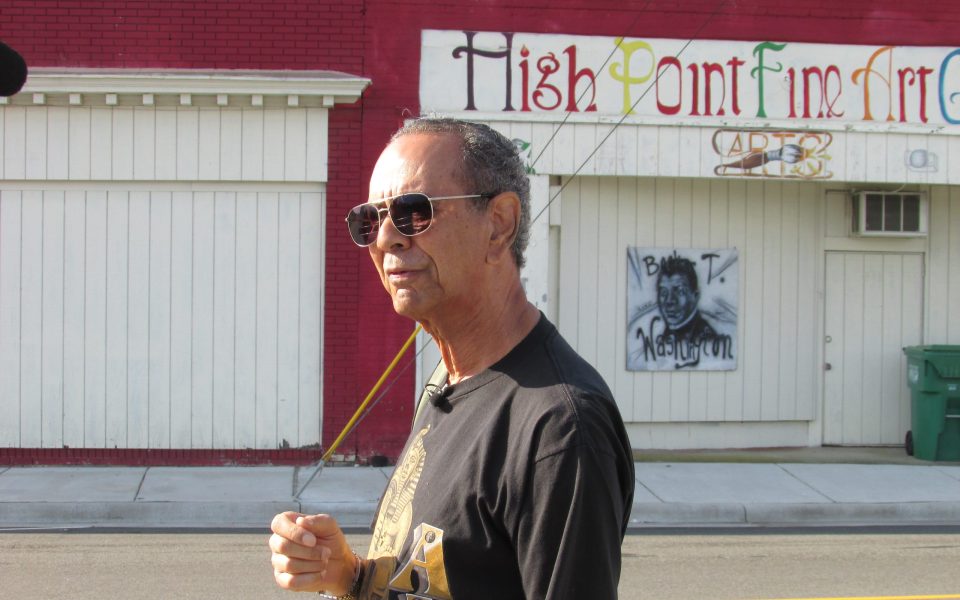Washington Street today might not be quite what it was back in the day. As the hub of black commerce and culture in High Point, it boasted two cab companies, multiple dentists and doctors, a law office, a YMCA and YWCA, a couple movie theaters and grills, a skating rink, a putt-putt golf course, two hotels and malt shop.
Still, it’s a pretty lively scene as Glenn Chavis, the pre-eminent historian of African-American life in High Point, gives a television interview to Spectrum News. Just as the cameraman sets up the shot, a barefoot woman fashionably dressed in black slacks and a pink top takes a seat on a metal bench, removes a flattened cardboard box and then reclines like a 1940s film siren with her arm flung back. Just then, a man riding past on bicycle while smoking calls out, “Hello people in TV land! Goddamn, I dropped my cigarette.” A man in a pickup blows his horn to greet Chavis, a familiar figure on the street.
Later, they move down the street to its eastern terminus and stage another shot near the Washington Quick Mart, where a sidewalk vendor is selling sundresses and shades. Chavis takes a break to alert me: “Did you see that transaction? Those two white ladies pulled into the parking lot, took care of business, and were in and out just like that.”
Three police officers on foot sweep down the street in the old-school manner, warily eying bystanders and waving curtly. They rouse the woman on the bench, who wasn’t sleeping so much as sunning.
Now in its sixth year, today the only takers for Chavis’ Washington Street tour are two reporters, but previously he’s guided the likes of Mayor Bill Bencini.
Washington Street flourished during the years of segregation. This Saturday morning, Chavis mentions a former slave named Hinton who initially opened a restaurant on Main Street, but was forced out in the 1910s as white supremacy consolidated in North Carolina, and Hinton wound up building an 11-room hotel on Washington Street. Conversely, integration in the 1960s offered black entrepreneurs access to larger markets and set in motion the district’s decline.
While segregation kept black dollars circulating in the black community, the injustice of Jim Crow inflicted plenty of tragedy. The two hospitals operating in High Point in the 1930s demonstrated how the color line might occasionally blur but tended to sharpen when the stakes were raised. Guilford General Hospital, located at the end of Washington Street, served only whites, Chavis said, while the more remote Burrus Memorial Hospital was open to both races.
Chavis’ grandfather came to the High Point from the mountains, and he was fair-skinned with straight hair. When his grandfather’s appendix ruptured, Chavis says, he was taken to Guilford General Hospital. His wife, who had dark skin, came to visit her husband, only to be told, “We don’t treat colored patients, and we don’t even have a colored janitor.” When the hospital staff found out Chavis’ grandfather was black, they put him out.
More tragically, Chavis recounts a story from the early ’30s about a “fair” woman of African descent who was dating a white man. They got into an argument in a cab, and he slit her throat. The cab driver dropped her off at Guilford General, but her vindictive lover called the hospital and informed the staff that the woman was black. Chavis says they bandaged up the woman’s neck and put her out on the curb, where she bled to death.
While white institutions dealt cruelly with black people in a segregated society, black establishments appear to have provided convenient opportunities to absorb blame when conflict arose within the white community.
A short-lived, black-owned silent movie theater that opened on Washington Street in 1912 was the setting for the death of Officer William Witcher, the first High Point police officer killed in the line of duty. Contemporaneous newspaper accounts uncovered by Chavis indicate that Witcher was on duty at the movie theater and Chief Ben Ridge and another officer arrived between 9 and 10 p.m. on a night in September 1913. The story also indicates that Witcher was killed while responding to a fight between two black men in September 1913.
“Officer Witcher told his wife: ‘If I die, sue the city because the police chief shot me,’” Chavis says.
While the coroner’s verdict indicated that the person who filed the pistol shot was unknown, one article states, “Chief [Ben] Ridge said two Negroes saw a white man whom they didn’t know fire the fatal shot from near the side of Chief Ridge. Another four Negroes saw the flash of the gun but could not identify the white man.”
The movie theater appears to have closed in the aftermath of the shooting.
Much later, when he was a teenager, Chavis recalls a more wholesome kind of excitement.
Speaking of the L&M Grill, located near the present-day Jackie’s Place nightclub, he says, “It was packed. After football games you couldn’t even move around in there.”
Join the First Amendment Society, a membership that goes directly to funding TCB‘s newsroom.
We believe that reporting can save the world.
The TCB First Amendment Society recognizes the vital role of a free, unfettered press with a bundling of local experiences designed to build community, and unique engagements with our newsroom that will help you understand, and shape, local journalism’s critical role in uplifting the people in our cities.
All revenue goes directly into the newsroom as reporters’ salaries and freelance commissions.





Leave a Reply